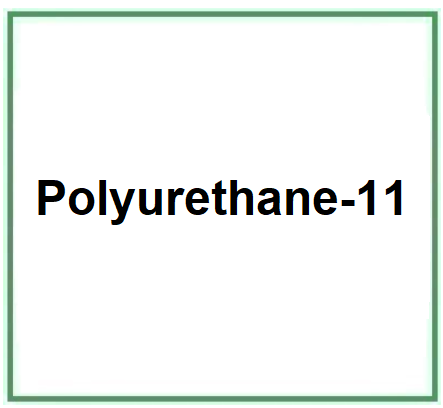Polyurethane-11 is an inorganic chemical compound, a segmented block copolymer derived from urethane and synthesised from isocyanates. Significant substances used: Adipic acid, 1,4-butanediol, isophthalic acid, methylene bis-(4-cyclohexylisocyanate), neopentyl glycol and trimethylolpropane copolymer.
The name describes the structure of the molecule:
- "Polyurethane" is a term that describes a class of polymers widely used in various applications due to their versatility and desirable properties such as durability, flexibility and abrasion resistance and temperature variations.
- "-11" is a reference to the specific type or grade of polyurethane, which can be characterized by such factors as the types of isocyanates and polyols used, their relative amounts, and the presence of any additives. . This is a designation used to differentiate different molecular structures or variants of the polymer. In cosmetic chemistry, these numbers can help formulators identify specific characteristics or behaviors of a given ingredient, particularly when a chemical family has multiple derivatives or forms.
Description of raw materials used in production and their functions.
- Adipic Acid. A key raw material in the formation of polyester polyols. It's a dicarboxylic acid.
- 1,4-Butanediol. A dihydric alcohol used as a reactive component in polyurethane formation.
- Isophthalic Acid. Another dicarboxylic acid contributing to the polyester structure.
- Methylene bis-(4-cyclohexylisocyanate). Provides isocyanate groups essential for polyurethane formation.
- Neopentyl Glycol. Another dihydric alcohol used in the formation of polyurethane.
- Trimethylolpropane. A trihydric alcohol introducing additional reactive sites in the polymer.
Step-by-step summary of industrial chemical synthesis process.
- Adipic acid, isophthalic acid, 1,4-butanediol, neopentyl glycol, and trimethylolpropane are reacted together to form a polyester polyol.
- The resulting polyol is reacted with methylene bis-(4-cyclohexylisocyanate).
- The reaction proceeds to form Polyurethane-11.
What it is used for and where
Cosmetics
Film-forming agent. It produces a continuous ultra-thin film with an optimal balance of cohesion, adhesion and stickiness on the skin or hair to counteract or limit damage from external phenomena such as chemicals, UV rays and pollution.
It appears as a white powder or colorless liquid.

Safety
Urethane (also called ethyl carbamate) is a by-product of fermentation and is considered a genotoxic agent.
Polyurethanes are rather complex, inert and biostable materials that are also used in biomedical applications. They are typically synthesised by the reaction of a glycol or polyol with polyisocyanate or diisocyanate. It is known that exposure to isocyanates can cause asthma, contact allergies, conjunctival and skin irritation. However, a study by the Cosmetic Ingredient Review Expert Panel in 2017 found that the rates of harmful residues are not significant for human health.
![]() Polyurethane-11
Polyurethane-11 

